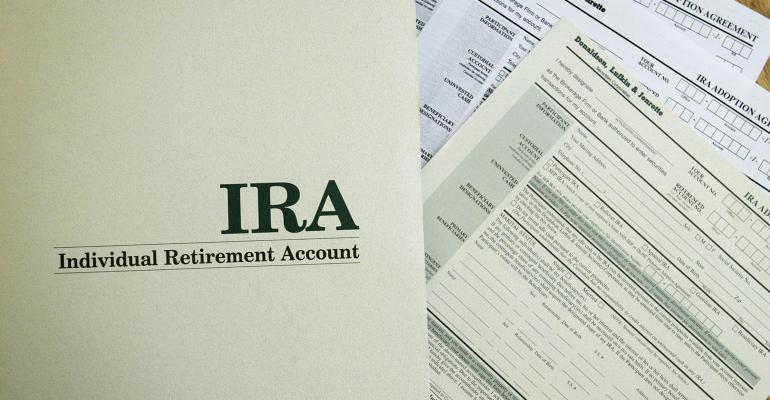Private Letter Ruling 202042012 (Oct. 16, 2020) provides practitioners with another example of qualifying a trust as a designated beneficiary and making post-mortem transfers of an individual retirement account out of a trust. Although the Setting Every Community Up for Retirement Enhancement Act (SECURE) made significant changes to the required minimum distribution (RMD) rules, the rules related to trusts as designated beneficiaries currently remain the same, and the common need to move inherited IRAs out of trusts continues.
Trust Named as IRA Beneficiary
An IRA owner died and named her trust as beneficiary of the IRA. The trust, which became irrevocable at the death of the IRA owner, was to be divided into separate shares for each of the IRA owner’s five children.
The trustee of the trust proposed to divide the assets of the IRA into five distinct IRAs, each for the separate benefit of one of the five children. Each transferee IRA would be maintained in the name of the IRA owner for the benefit of the child beneficiary, as beneficiary of the trust (commonly referred to as an “inherited IRA”). The taxpayer requested the following rulings:
- Each child beneficiary of the trust is treated as having been designated as a beneficiary of the IRA for purposes of determining the distribution period and that RMDs can be calculated using the life expectancy of the oldest child.
- The trustee of the trust can transfer the assets of the IRA by means of trustee-to-trustee transfers to inherited IRAs to separate the interest of each child beneficiary in the assets of the IRA, without such transfers constituting taxable distributions or rollovers.
Four Requirements
For a trust to be considered a designated beneficiary under the Internal Revenue Code Section 401(a)(9) regulations governing RMDs from IRAs, the following requirements must be met:
- The trust is a valid trust under state law, or would be but for the fact that there is no corpus.
- The trust is irrevocable or will, by its terms, become irrevocable on the death of the employee.
- The beneficiaries of the trust who are beneficiaries with respect to the trust’s interest in the employee’s benefit are identifiable within the meaning of Treasury Regulations Section 1.401(a)(9)-4, A-1 from the trust instrument.
- The documentation described in Treas. Regs. Section 1.401(a) (9)-4, Q&A 6 has been provided to the plan administrator (this requirement can be satisfied by providing a copy of the trust to the plan administrator by Oct. 31 of the year following the year of the owner’s death).
In this PLR, the children were the only beneficiaries of the trust, and the IRS determined that the trust satisfied all four of the above requirements. When these requirements are satisfied, the beneficiaries of the trust (and not the trust itself) will be treated as having been designated as beneficiaries for purposes of determining the distribution period. In that case, because the IRA owner died before 2020, the life expectancy of the oldest trust beneficiary (that is, the oldest child) could be used to determine RMDs. (If the IRA owner had died after 2019, the changes made to the RMD rules under the SECURE Act would have applied. In PLR 202042012, however, the IRA owner died before the applicability date of the SECURE Act amendments.)
If the trust had not met the above requirements, the owner is considered to have no designated beneficiary, and the IRA would have had to be distributed in five years if the IRA owner died before her required beginning date (RBD) or over the IRA owner’s remaining life expectancy if she died on or after her RBD.
Transfers to Inherited IRAs
In this ruling, the trustee of the trust also wanted to transfer the IRA, by means of trustee-to-trustee transfers (although indirect rollovers aren’t allowed for nonspousal inherited IRAs, direct rollovers, or trustee-to-trustee transfers, are permissible), to separate inherited IRAs, one for the benefit of each child, as beneficiary of the trust. Each such inherited IRA would use the Social Security number of the individual child beneficiary for tax reporting purposes.
Fiduciaries often desire to make similar transfers when a trust pays outright to beneficiaries. In those situations, fiduciaries naturally wish to distribute the benefits in the most tax efficient manner to effectuate the closing of the trust. In this PLR, the IRS illustrates how this can be accomplished by allowing the trustee of a trust transfer the IRA to inherited IRAs for the benefit of the individual trust beneficiaries.
This ruling aligns with a number of other PLRs the IRS has previously issued allowing an estate or trust fiduciary to transfer an IRA to an inherited IRA for the benefit of the estate or trust beneficiaries. The majority of the PLRs on this subject, including this one, cite Revenue Ruling 78-406, which states that the direct transfer of funds from one IRA trustee to another IRA trustee doesn’t constitute a payment or distribution to a participant, payee or distributee. The revenue ruling stated that in the absence of payment or distribution, a trustee-to-trustee transfer wouldn’t be a rollover contribution described in IRC Section 408(d)(3)(A) because the funds aren’t within the direct control and use of the participant. While PLRs can’t be used or cited as precedent, they do provide important insight as to the IRS’ interpretation of the law.





